2011 Buick Regal on the Nürburgring – Click above for high-res image gallery
The thought of holding a vehicle launch drive for a new Buick sedan at Germany's Nürburgring race track would have been considered utterly absurd 18 months ago to just about anyone except Jim Federico. Federico is General Motors' vehicle line executive for its global mid-size car platform code-named Epsilon II. In those late pre-bankruptcy days, few outside of Federico's team had any idea what Buick had in its pipeline.
In that intervening period, Saturn, Pontiac and Hummer have all passed into the history books and Saab has been sold off. The car that was intended to have become the second generation Saturn Aura has now been re-purposed in North America as the all-new Buick Regal. We had a brief introduction to the car last fall, but when the time came to really exercise the Regal, Buick invited us to its birthplace in Germany to show off its moves. Is the Regal really a genuine European sports sedan as our title claims? Read on to find out.
Photos by Sam Abuelsamid / Copyright ©2010 Weblogs, Inc. and General Motors
The first Epsilon II vehicle to come to market was the Opel Insignia in mid-2008. The Regal for North America was a comparatively late addition to the Epsilon II lineup, although the Buick version has been part of the plan from day one for the Chinese market, and as such launched just months after the Insignia in late 2008.
The GM Europe engineering team working out of Russellsheim, Germany has primary responsibility for development of the mid-size platform with additional input and support coming from engineering and design teams in the United States and Asia. While developing the Insignia, the intent has always been to take it upmarket from the European-only Vectra it replaced to compete directly with Audi, BMW and Mercedes-Benz. Federico and his team wanted the Insignia to be taken seriously as a German sports sedan, something the Vectra never really achieved.
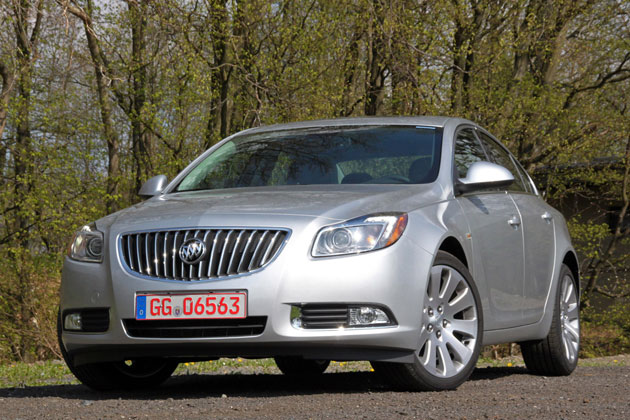
Buick already offers an Epsilon II-based model in North America as the LaCrosse. The Regal, however, is being targeted at a very different customer than its larger brother. The LaCrosse is more luxury oriented with Buick seeing the Lexus ES350 and Acura TL as its primary competitors. The Regal will be marketed as a more sporting sedan aimed at the Acura TSX and Volkswagen CC.
Like GM's new global compact (Delta II) platform, this larger architecture was developed to conform with all the different regulatory requirements in Europe, North America and Asia at the same time. In order to do that, the structural engineers spent months going through hundreds of thousands of simulation iterations in order to create a common design. In spite of all the emphasis on commonality, there are still elements that just have to be unique to each market, including the car's head and tail lamps, rear view mirrors and grille.
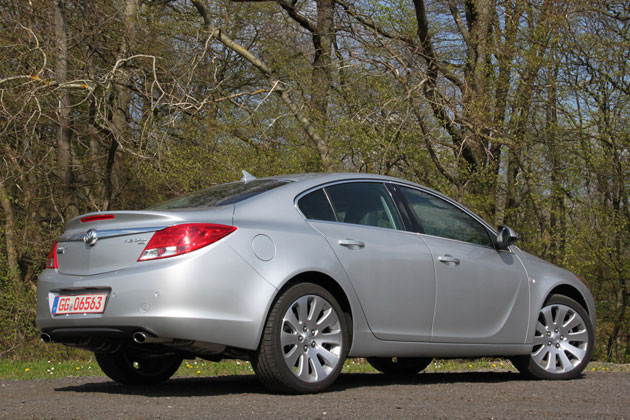
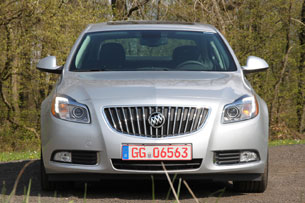
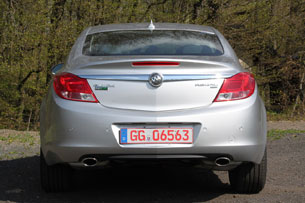
Federico explained that the development team decided early on to make the regionally unique components plug and play. For example, the different rules in Europe and the U.S. require different headlamp innards. It's possible to remove the lamp module from a German Insignia and simply plug in a U.S.-spec Regal unit. The mounting points and wiring connectors are common on all variants. Similarly, the Regal's signature waterfall grille can be popped out and replaced with an Opel grille. Even under the skin, the bumper bars from the different variants can be swapped out with just a few bolts.
This flexibility has allowed GM to easily produce multiple variants of the Insignia/Regal on the same assembly line. The Opel factory in Russellsheim has been building production Regals for North America for several weeks now and will continue to do so for another year. Before driving the Regal we toured the Russellsheim factory and saw Regal sedans and Insignia sedans, hatchbacks and wagons interspersed on the assembly line.
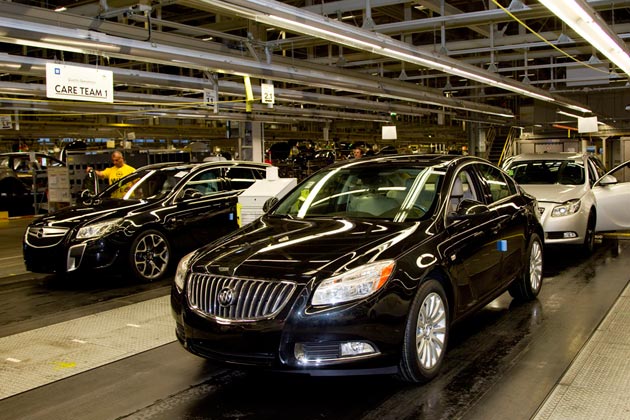
U.S.-spec Buick Regal being assembled alongside an Opel Insignia OPC Sports Tourer
The first boatload of U.S.-spec Regals arrived at the port of Newark, New Jersey last week and more are on their way in the coming weeks as GM prepares to start selling its new mid-size sedan in late May. The Russelsheim plant is scheduled to build about 26,000 Regals in calender 2010 with another 14,000 in 2011 before the Oshawa, Ontario assembly plant ramps up production and takes over.
Aside from the Buick grille and the inner details of the lamp modules, the Regal is virtually indistinguishable from the Insignia sedan, and that is a very good thing. Design manager Malcolm Ward explained that the team aimed to create a look that was muscular and sculpted while at the same time having very low aerodynamic drag. Depending on the body style, suspension and wheel/tire package, the Insignia's drag coefficient ranges from 0.25-0.30.
Since the Insignia was designed for the German market where triple digit autobahn speeds are not uncommon, low drag is not enough. Managing lift is also critical to maintaining stability at autobahn speeds. The rear deck has been shaped to keep lift to a minimum without having to resort to any extra spoilers, at least on the sedan. The European-only (for now at least!) five-door hatch does have a small lip spoiler thanks to its shorter deck.
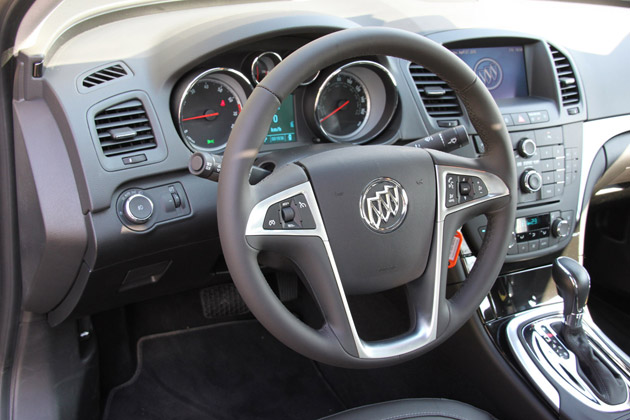
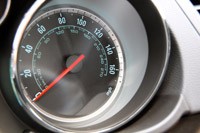
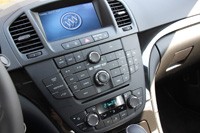
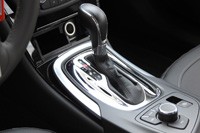
The Regal's interior is also common with the Insignia but distinct from the LaCrosse. The LaCrosse gets a broad, flat dashboard with a floating gauge pod and center cluster. The Regal's design has more of a dual cockpit layout with a driver-oriented layout. Thus, the Regal has a cozier feel although its interior volume is comparable to the LaCrosse. The materials have a high quality feel and fit and finish was consistently excellent across all of the cars that we sampled.
One of our biggest complaints about the LaCrosse since day one has been its enormous A-pillars, which cause substantial blind spots. The Regal pillars are considerably slimmer and overall visibility is superior to the LaCrosse in all directions. According to Federico, the engineering team is working on slimmer pillars for the LaCrosse as well and we may see a running change next year.
The Regal has four inches less between its axles so the back seat isn't as commodious as the LaCrosse, but there is still plenty of room for two adults or three kids across the rear bench. The front seats are the same as those in the LaCrosse, which means they are very comfortable. However, the seats in the more sporting Regal are a bit wide and drivers may find them somewhat lacking in lateral support when they hit the twisty stuff.
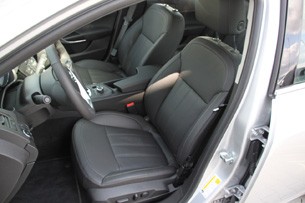
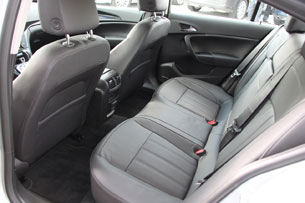
All Regals will be mid-level CXL models with leather interiors for the duration of the 2011 model run. Next year the more performance-oriented GS and a base trim level will be added. The base models will get a new seat covering that combines a woven fabric center insert and protein-based vinyl covering for the side bolsters.
While European customers have access to a range of gas and diesel engines, North American customers will initially get two four-cylinder engines. When the first Regals arrive at dealerships in May, they will all be powered by the now familiar 2.4-liter direct-injected Ecotec inline four-cylinder with 182 horsepower and 172 pound-feet of torque. This 2.4-liter will be paired with the same 6T45 six-speed automatic found in a number of GM vehicles.
Regals powered by a 2.0-liter turbocharged and direct-injected inline four-cylinder will start rolling off the boat in August pumping out 220 horsepower and a very healthy 258 lb-ft that peaks at just 2,000 rpm. The first batch of turbo Regals will all have automatic transmissions, but buyers will also have the option to get a six-speed manual gearbox later this fall, a first for the Regal.
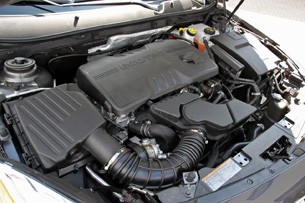
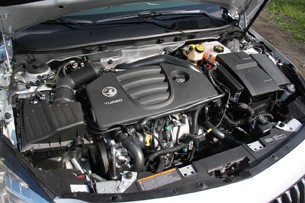
The Regal's naturally aspirated 2.4-liter (left) and turbocharged 2.0-liter (right) four-cylinder engines
For our driving evaluation we had a mix of normally aspirated and turbo Regals, all with automatic transmissions. Despite the fact that we would be driving on the autobahn and Nürburgring, the suspension, brakes and all-season tires on each Regal we drove were the same parts that will be on cars going to American customers. Since the turbo models weren't final production units yet, their molded plastic engine covers were still wearing UK market Vauxhall badges.
Before we hit the autobahn, we spent a couple of hours exercising the Regal at Opel's Dudehofen proving ground. The proving ground staff were polite enough to spray the vehicle dynamics pad with water and we got to run the Regal through some slalom, moose test and brake-and-steer maneuvers.
The slalom was an excellent test of the Regal's hydraulically assisted steering, as well as the basic transient response of the suspension. Unlike the legendary turbo-V6 Regals of the 1980s, these cars can actually change direction with surprising agility and brake hard repeatedly without immediately fading, a trait that would prove handy the next day.
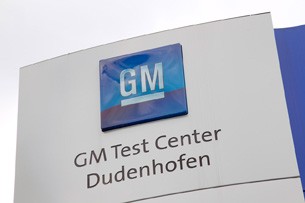
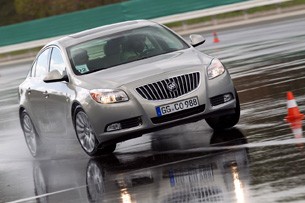
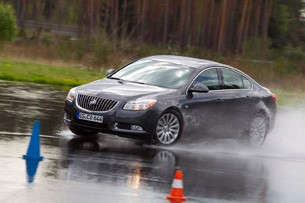
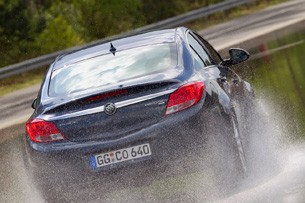
The moose test became famous back in the late-1990s when a Swedish magazine rolled an early Mercedes-Benz A-Class in a simulated obstacle avoidance maneuver. The test involves entering a gate of cones, making a quick change to the adjacent lane as if to avoid an obstacle in the car's path, and then returning to the original lane. We ran the test at progressively higher speeds up to about 45 mph and the Regal was rock solid stable. The stability control was seamless when it did activate, simply keeping the car on the requested course without ever feeling like it was jerking the car around. (A tip of the hat to the author's former colleagues at TRW for their work on the stability control).
The day after our test track session we picked up our fleet of Regals at the Russellsheim factory outside of Frankfurt for an on-road drive. In addition to the automatic transmission cars that we drove at Dudenhofen, Buick brought along a pair of Insignias with the 2.0-liter turbo and six-speed manuals for us to sample.
We set out northwest from the factory on the autobahn toward Cologne and the Eiffel mountains, home of the world's longest and most dangerous racetrack, the Nürburgring. Starting in the early-1980s when brands like BMW were gaining in popularity in the U.S., GM tried to foist off so-called "Euro-sedans" on its customers with nothing more than blacked-out trim, stiffer springs and alloy wheels with Goodyear Eagle tires. Needless to say, none of these cars ever achieved the level of dynamic sophistication that made the real European sedans so special.
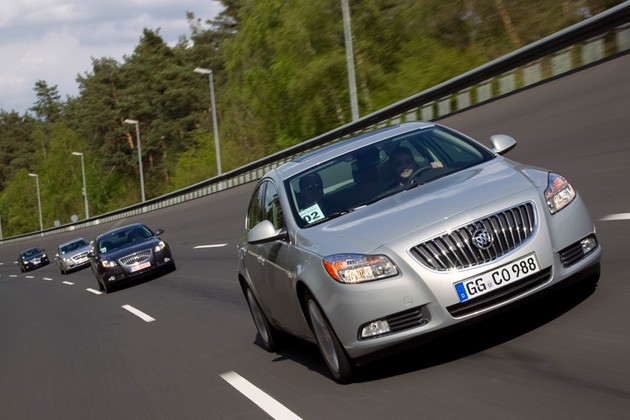
By letting us drive the Regal in the birthplace of the sports sedan, Buick sought to demonstrate that Federico and his crew have created the real deal without watering it down for America. Ever since the Insignia replaced the Vectra in 2008, it has been attracting an increasingly upscale buyer and more than doubled its conquest sales to over 20 percent. Of those conquests, two-thirds are coming from premium brands like BMW, Audi and Mercedes-Benz.
In and around urban areas like Frankfurt and Wiesbaden, autobahn speeds are generally restricted to anywhere from 60-80 miles per hour. Because German police are often sticklers for enforcing posted limits, we stuck to those limits when required. But once we saw the unrestricted speed sign, we put our right foot down to see what the Regal was really made of.
The Regal is truly worthy of being called a sports sedan.
We had no problem getting up to and sustaining 125 miles per hour in Regals powered by the normally aspirated 2.4-liter engine. We saw an indicated 138 mph in the turbo model before we approached traffic and had to back off. In the days of the Regal GNX, hitting those kinds of speeds was possible in a straight line but not at all recommended for sustained driving. This new breed of Regal has exactly the characteristics we would expect of any German-bred machine out of Munich, Ingolstadt or Stuttgart.
The Regal always felt rock solid stable in a straight-line, but life rarely takes you in a straight line for very long unless you live in the plains states. Curves on a highway that seem inconsequential at 70 mph suddenly generate serious lateral loads at 120 mph. The hydraulic steering of the Regal was perfectly weighted with no slop or steering dead spots that we could find. Feedback was surprisingly good and much better than we've experienced in the TSX. Aerodynamic stability was also excellent and the Regal never felt like it was getting light on its tires.
All of the cars we drove (apart from the two Insignias with manual transmissions) were equipped with U.S.-spec all-season tires and non-metallic brake pads. Federico was insistent that we should experience how good his car was even in pure American form. As it turned out, he had nothing to worry about.
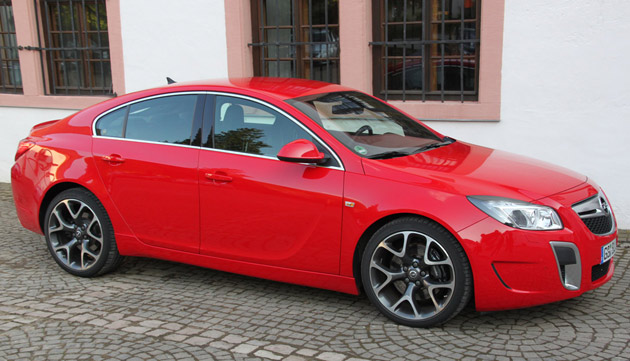
The real fun started once we exited the autobahn to head west towards the Nürburgring. Following a driver change we got some seat time in the manual gearbox Insignia. Despite the grille and badging on the car, the powertrain was identical to what will come to America this fall. It's no secret that we favor shifting for ourselves whenever possible, but the GM-built gearbox in the Insignia has both a notchy action to it and somewhat long throws. It's possible the notchiness may be the result of hard testing on the particular example we drove, so we'll reserve final judgement until we drive a production unit.
Despite our quibbles with the shift action, the turbocharged four-cylinder certainly chips in to compensate. We've loved previous iterations of this engine in cars like the Pontiac Solstice GXP and Chevrolet Cobalt SS. In the Regal, the power is dialed back a bit from 260 hp to 220 hp, but the 258 lb-ft of torque hits its peak at just 2,000 rpm and stays there almost to the 6,350 rpm redline. The flexibility afforded by all that torque means that shifting can be more discretionary.
We hopped into a full U.S.-spec automatic turbo Regal once we arrived at the 'Ring. At 12.7 miles long with 73 official turns, the Nürburgring is considered the toughest and most dangerous track in the world. Learning this track is difficult and takes far more time than we had in our short visit. The day we were there was one of the industry days when the track is closed to the public for manufacturer testing. Fortunately for us, GM was able to arrange 60 minutes of closed track time.
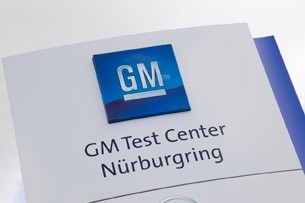
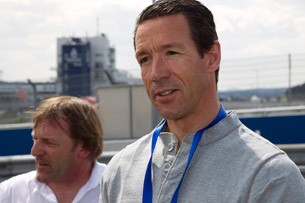
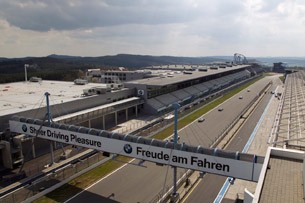
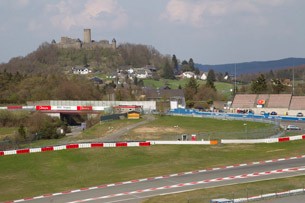
GM also arranged for race drivers Joachim Winkelhock and Manuel Reuter to join us for some lead and follow on the track. Winkelhock and Reuter drove a pair of high performance Insignia OPCs and we followed in groups of three Regals. This allowed those of us with limited 'Ring experience (two previous visits for this writer) to simply follow their line and focus on pushing the car as hard as possible without having to worry about where the next blind corner went.
Even with U.S.-spec tires and brakes, the Regal proved to be utterly capable of being flogged on the 'Ring, at least for two laps. The chassis is very nicely balanced, and just as we saw at the proving ground the day before, the stability control kicked in seamlessly. Steering feedback and brake modulation were also excellent and understeer minimal. We took a lap in both the turbo and normally aspirated cars and the 2.4-liter was definitely running out of steam with the 1,000 feet of elevation change. We achieved 115 mph with the 2.4-liter and 124 mph with the turbo on the main straight leading up to the final turns.
While the pavement on the track is smooth these days, there are still plenty of bumps, some of which can send a race car completely airborne. The Regal, however, has the same excellent body control that we've experienced in the LaCrosse. The 18-inch tires on the 2.4-liter model, however, definitely felt more squirmy than the 19-inch tires on the turbocharged model. The brakes remained relatively fade free over the course of two laps, and while there was that familiar smell of hot brake linings, there was no smoke pouring from the wheel wells.
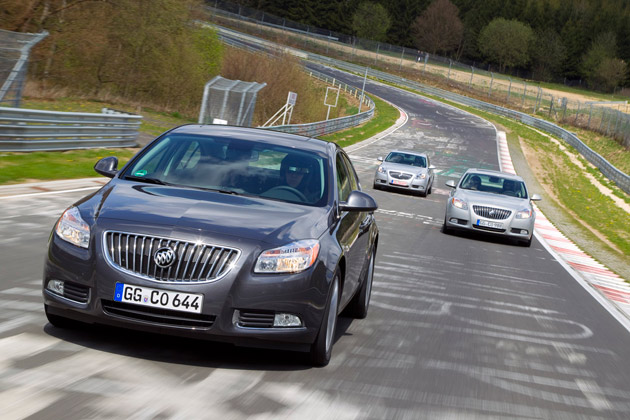
The same could not be said after our taxi ride on the 'Ring. Once we finished our laps with the Regal, we climbed into the OPC cars three at a time with Reuter and Winkelhock for a serious hot lap. Although the Insignia OPC has never recorded an official lap time on the Nordschleife, GM officials hint that the 325-hp all-wheel-drive sedan can run it under nine minutes. With four adults on board, Winkelhock was drifting the Opel through corners as he chased down Reuter. Smoke was pouring out of the wheel wells after we climbed out back in the pits. For those visiting the Nürburgring who don't have the nerve to drive it themselves, there is a fleet of BMW M5 "taxis" that offer similar rides with pro drivers.
Our 60 minutes of 'Ring time was up all too soon and we had to head back out on public roads. As we made our way back to Wiesbaden, the Regals again proved that Federico and his team had not transformed last year's European car of the year into an old-school Buick. They have instead continued the transformation of Buick into a brand that can compete toe-to-toe with the likes of Audi, Acura and even BMW. For the first time in its history, the Regal is truly worthy of being called a sports sedan.
Photos by Sam Abuelsamid / Copyright ©2010 Weblogs, Inc. and General Motors
Our travel and lodging for this media event was provided by the manufacturer



Sign in to post
Please sign in to leave a comment.
Continue